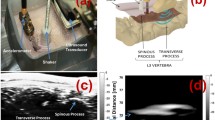Summary
Accelerations of vertebrae during whole-body vibration (WBV) are used in occupational biomechanics for the prediction of internal stress. To avoid invasive techniques, a method for the calculation of bone accelerations was developed using measurements on the skin. The soft tissue between spinous processes L3 and T5 and miniature accelerometers stuck to the skin over them was modelled by a simple Kelvin element, whose parameters i.e. angular natural frequencyω n4 and critical dampingζ describe an approximate transfer function between the bone (input) and the skin surface (output). The parameters were determined from free damped oscillations of the accelerometer-skin complex in the Z-axis, and depended significantly on the factors “subject” and “point of measurement”. In one subject, the time courses of bone accelerations during sinusoidal WBV (4.5 and 8 Hz; 1.5 m·s−2 RMS) were calculated using separate transfer functions for each of 11 different spinal levels. Since the output signals on the skin were non-sinusoidal, the skin accelerations had to be treated with an inverse transfer function in the frequency domain. A comparison of accelerations measured on the skin and predicted for the bone mainly indicates that absolute peak values of bone accelerations are smaller and occur earlier. Both kinds of acceleration hint at differences in WBV-induced internal stress within the spine.
Similar content being viewed by others
References
Artmann M, Kaltschmidt H, Viernstein K, Wirth CJ (1976) Das Verhalten der Beschleunigungsübertragung vom Beckenkamm auf einen äußeren Beschleunigungsaufnehmer beim Menschen. Biomed Techn 21:213–221
Blüthner R, Hinz B, Seidel H (1986) Zur Möglichkeit einer Abschätzung der Wirbelsäulenbeanspruchung durch Ganzkörpervibration unter experimentellen Bedingungen. Z Ges Hyg 32:111–113
Buchholz Ch, Kramer H, Rothe R, Seidel H (1976) Vorbedingungen für den elektrischen Nachweis von Aktivitätsunterschieden an der Rückenstreckenmuskulatur bei vorgegebener Körperhaltung. Z. Ges Hyg 22:332–335
Chaffin B, Andersson BJ (1984) Occupational biomechanics. John Wiley & Sons, New York
Christ W, Dupuis H (1966) Über die Beanspruchung der Wirbelsäule unter dem Einfluß sinusförmiger und stochastischer Schwingungen. Int Z Angew Physiol 22:258–278
Denoth J, Gruber K, Ruder H, Keppler M (1985) Forces and torques during sports activities with high accelerations. In: Perren SM, Schneider E (eds) Biomechanics: current interdisciplinary research. Martinus Nijhoff Publishers, Dordrecht Boston Lancaster, pp 663–668
Draft for Development (1973) Guide to the safety aspects of human vibration experiments, DD23, Gr 7. British Standard Institution, London
Franke EK (1951) Mechanical impedance of the surface of the human body. J Appl Physiol 3:582–590
Furnee EH (1986) Innovation in video-digital coordinate measurement for movement analysis: real-time, high resolution, estimation with high-speed stroboscopic TV. In: Abstract Book of the Fifth meeting of the ESB. Berlin (W), p 134
Gierke von HE, Oestreicher HL, Franke EK, Parrack HO, Wittern WWv (1952) Physics of vibrations in living tissue. J Appl Physiol 4:886–900
Hinz B, Seidel H (1986) On the nonlinear internal stress of the human body during sinusoidal whole-body vibration. In: Jansons H, Kalnbers V (eds) Trends in human biomechanics research and application in medicine and surgery. Min Health, Riga, pp 450–456
Hinz B, Seidel H (1987a) The nonlinearity of the human body's dynamic response during sinusoidal whole-body vibration. Ind Health 25:169–181
Hinz B, Seidel H, Bluethner R (1985) On the effects of whole-body vibration on the spine — the significance of the human biodynamics. In: Frolov KV (ed) Proceedings of the second international CISM-IFToMM Symposium. Moscow, pp 56–60
Hinz B, Seidel H, Bräuer D (1987b) Transmission characteristics of the human spine for low-frequency whole-body vibration. XIth International Congress of Biomechanics, Amsterdam, June 28–July 3
Hinz B, Seidel H, Bluethner R (1988) The internal stress of the human body during whole body vibration. In: Jansons H, Kalnbers V (eds) Trends in human biomechanics research and application in medicine and surgery. Min Health, Riga, vol 5 (in press)
Krause H (1963) Das schwingungsmechanische Verhalten der Wirbelsäule. Int Z Physiol 20:125–155
Lafferty JF (1978) Analytical model of the fatigue characteristics of bone. Aviat Space Environ Med 49:170–174
Lange W, Coermann R (1964) Relativbewegungen benachbarter Wirbel unter Schwingungsbelastungen. Int Z Physiol 21:326–334
Liu YK, Ray G (1975) Dynamic response of human spine in (+g z) acceleration — a two dimensional model. In: Skalak R, Nerem RM (eds) Applied mechanics conference. The Reusselaer Polytechnic Institute, Troy New York, pp 23–25
Oestreicher HL (1951) Field and impedance of an oscillating sphere in a viscoelastic medium with an application to biomechanics. J Acoust Soc Am 23:707–714
Panjabi MM, Andersson GBJ, Jorneus L, Hult E, Mattson L (1986) In vivo measurements of spinal column vibrations. J Bone Joint Surg 68-A:695–702
Sandover J (1981) Vibration, posture and low-back disorders of professional drivers. Report DHS 402 Univ Techn Loughborough, 141 p
Seidel H, Heide R (1986) Long-term effects of whole-body vibration: a critical survey of the literature. Int Arch Occup Environ Health 58:1–26
Seidel H, Beyer H, Blüthner R, Bräuer D, Hinz B, Menzel G, Weissmüller A (1984) Electromyography in back research — assessment of static and dynamic conditions. In: Perren SM, Schneider E (eds) Biomechanics: current interdisciplinary research. Martinus Nijhoff Publishers, Dordrecht Boston Lancaster, pp 611–616
Seidel H, Bluethner R, Hinz B (1986) Effects of sinusoidal whole-body vibration on the lumbar spine: the stress-strain relationship. Int Arch Occup Environ Health 57:207–223
Varju D (1977) Systemtheorie. Springer, Berlin Heidelberg New York
Weeren PR van, Barneveld A (1986) A technique to quantify skin displacement in the walking horse. J Biomech 19:879–883
Author information
Authors and Affiliations
Rights and permissions
About this article
Cite this article
Hinz, B., Seidel, H., Bräuer, D. et al. Examination of spinal column vibrations: a non-invasive approach. Europ. J. Appl. Physiol. 57, 707–713 (1988). https://doi.org/10.1007/BF01075992
Accepted:
Issue Date:
DOI: https://doi.org/10.1007/BF01075992




